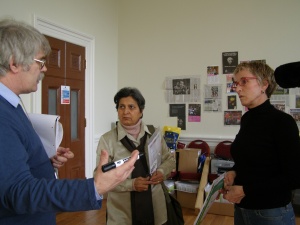Telling the conference story
Mike Jempson

St George’s Hall in the middle of Liverpool is a challenging venue for a 21 century European conference on inter-culturalism. The £23 million spent on its refurbishment has done nothing to eradicate the echoes of empire. Opened in 1854 to house music festivals and a courtroom, it remains an over-powering construction. As we set up our ‘virtual newsroom’ amidst its vast gloomy emptiness we all wondered how we could tell ‘the story’ of inter-culturalism from a city that earned its wealth from the slave trade. Unbeknownst to us Brouhaha troubadours will point the way by the end of the first day.
First things first – film the set up. That’s the easy bit. Then get our disparate team together to compare notes and agree a running order, and film that. All very post-modern. Telling a story about story-telling by showing how the story tellers construct the story.

And while we are at it, why not an ironic arty ‘installation’ to demonstrate just how disposable our efforts can be – not a cat tray filled with newsprint but a washing line amid drifts of newsprint, so passers-by can wring out the inevitable lies and distortions that emerge when time constraints limit our professionalism, or when profit-making and propaganda overtake the desire to tell the truth.

And as for deadlines – the adrenalin pump that keeps we hacks alive – let’s premiere the film at the final session before the delegates depart for home stimulant. In the meantime we’ll pick up stories and quotes and pictures as we come across them. The conference is trying to be different so we can try too – but our trade has its own internal disciplines that are hard to abandon. We have spelled them out in notes for those delegate who want to become citizen journalists while they are here – find the facts, check they are accurate, quote eye-witnesses and reliable sources, construct the story clearly, know your audience, and always distinguish between comment and fact.
Our inter-cultural team has print and broadcast and on-line experience and all the digital paraphernalia of the robo-hack. We hail from Cameroon and Greece and India and Ireland and Pakistan and Serbia. Three men, five women pooling our resources to keep the three days covered inside and outside the conference venue.
Our aim: to collect and disseminate material that speaks of inter-culturalism – the debate, the dilemmas, the diversity – and encourages others (especially our media colleagues) elsewhere to find new ways of making space for those whose voices are seldom heard, and using the immense power of mass media for cohesion instead of confusion.
It would help in the Internet was working, but apparently the City Council is worried we’ll spend the next few days viewing porn and stealing people’s identities. Leave that to the ’techies and get on with the story.
Soon the teams are at work, snapping shots of anyone and anything that takes our fancy, shooting footage that will generate instant nostalgia in just a few days time, interviewing cultural gurus and their acolytes, and listening out for gems of wisdom and the gaffes that make people grin.
We select our storytellers unsure what stories they will tell, and send them off on location to places delegates may see on Saturday, or may never see because the local authorities would prefer we did not disturb their plans to up-end ‘the world in a street’ in the name of regeneration.
Journalism is always about uncovering uncomfortable truths, but is also about telling positive stories too. We set to work, hoping our efforts will bear some fruit, here, there and in cyberspace. The legacy of such conferences now last longer than ever thanks to the information super-highway… if anyone can find the way through the myriad spaghetti junctions and the wayside blogs.
We hope our signals will point the way towards a future where diversity is recognised as a force for good, and where journalism will be appreciated because it allows different voices to emerge from the multitude and contribute to common understanding of our shared humanity.
And, of course, we hope there’ll be applause when our story is screened.





















